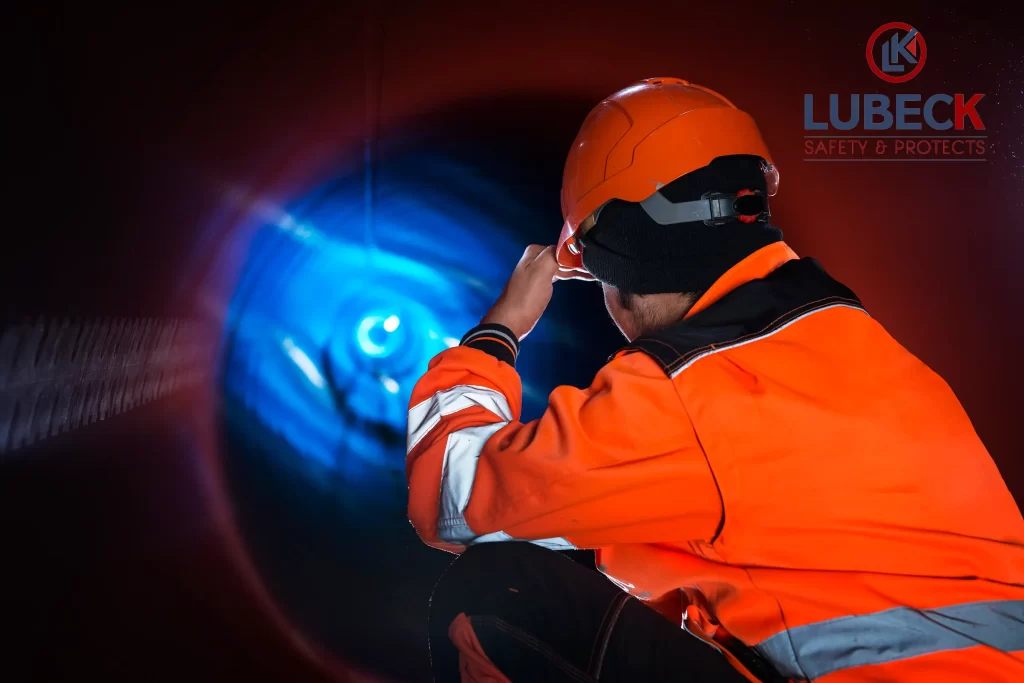- +916235962803
- info@lubecksafety.com
Confined spaces—areas that are not designed for continuous human occupancy but may require workers to enter for maintenance, repairs, or inspections—pose significant hazards. These environments often involve restricted airflow, limited visibility, or the potential for hazardous atmospheres, making them inherently dangerous. To safeguard workers in these environments, proper confined space entry procedures and fall protection systems are critical. Additionally, having a solid rescue plan in place is essential to ensure quick and effective response in the event of an emergency.
Confined space fall protection refers to the systems, equipment, and procedures that are put in place to protect workers who are required to enter confined spaces, such as tanks, silos, manholes, and sewers. These spaces are often difficult to navigate and may involve significant fall risks. Fall protection for confined spaces typically includes a combination of harnesses, lifelines, anchor points, ventilation systems, and rescue plans to protect workers from both falls and other hazards unique to these environments.
Confined Space Entry Procedures
Before entering a confined space, a proper entry procedure must be followed, including a risk assessment to identify potential hazards such as falls, toxic gases, low oxygen levels, or physical obstructions. Entry procedures should also include adequate communication plans, proper signage, and a confined space permit system to ensure safety throughout the work process.
Fall Arrest Systems
Workers entering confined spaces may be exposed to significant fall risks, particularly if they are required to work at heights or near openings. Fall arrest systems, such as harnesses, lanyards, and self-retracting lifelines (SRLs), are designed to prevent workers from falling if they lose their balance or footing while inside a confined space. These systems are connected to secure anchor points outside the confined space to ensure safe attachment.
Confined Space Ventilation
Proper ventilation is critical for maintaining a safe working environment in confined spaces. Ventilating the space helps prevent hazardous atmospheres, such as the accumulation of toxic gases or low oxygen levels, from developing. Ventilation systems, including blowers or exhaust fans, should be used to supply fresh air and remove harmful gases, ensuring that the environment remains safe for workers to perform their tasks.
Rescue Systems
In the event of an emergency, a rapid rescue plan is essential. Rescue systems may include specialized equipment such as tripods, winches, and rope rescue systems. These devices are designed to safely extract workers from confined spaces if they become incapacitated or fall. Rescue systems should be specifically designed and tested for the type of confined space being entered, ensuring that they are capable of responding quickly and efficiently.
Entry and Exit Ladders or Platforms
Ensuring safe access and egress is crucial for workers in confined spaces. Ladders, stairs, and platforms should be securely installed and easily accessible. For spaces with deep or vertical shafts, tripods or hoisting equipment may be necessary to safely raise and lower workers, providing a secure means of entry and exit.
Atmospheric Monitoring
Before and during confined space entry, it is essential to monitor the air quality for the presence of hazardous gases or a lack of oxygen. Gas detectors should be used to monitor for toxic gases like hydrogen sulfide (H₂S), carbon monoxide (CO), or methane (CH₄), as well as oxygen levels. Continuous monitoring is crucial for ensuring the safety of workers while they are inside the confined space.
Personal Protective Equipment (PPE)
PPE plays a critical role in protecting workers from confined space hazards. Respirators, protective gloves, helmets, and coveralls may be required depending on the nature of the confined space and the tasks being performed. PPE helps protect workers from both environmental hazards and physical injury.

At Lubeck Safety, we specialize in designing and implementing customized confined space fall protection and rescue systems tailored to the specific needs of your workplace. Our team of experts will conduct a thorough risk assessment, develop a comprehensive safety plan, and install the necessary equipment to ensure that your confined space operations are safe and compliant with all relevant regulations.
Contact us today to learn more about our confined space and rescue fall protection solutions. Let us help you create a safe and secure work environment for workers entering confined spaces, ensuring that they are fully protected from fall hazards and ready to respond in case of an emergency.
A confined space is defined as a work environment with limited or restricted entry and exit, typically characterized by access points smaller than 24 inches in diameter. All job sites classified as confined spaces must be equipped with OSHA-approved rescue equipment to ensure the safe retrieval of employees who may be unable to exit the hazardous area without assistance.
Over the years, our vendor partners have introduced numerous innovative fall protection and confined space rescue and descent products, many of which have become industry standards. Each of our rescue and descent systems is designed in close collaboration with end-users to address specific application needs. This approach ensures enhanced comfort, greater productivity, and full OSHA compliance, prioritizing worker safety at heights.
For decades ,Lubeck Safety is a authorised distributor for multi national brands providing general safety equipment for industrial use, protective personal wear, head protection and safety shoes, road safety products, PPE and many more safety products and safety equipment serving Oil and gas , construction , marine and aviation industries .We invite you to take a look around our website and learn more about our products and the organization behind the brand.
For decades ,Lubeck Safety is a authorised distributor for multi national brands providing general safety equipment for industrial use, protective personal wear, head protection and safety shoes, road safety products, PPE and many more safety products and safety equipment serving Oil and gas , construction , marine and aviation industries .We invite you to take a look around our website and learn more about our products and the organization behind the brand.
©2021. Lubeck Safety. All Rights Reserved.
WhatsApp us